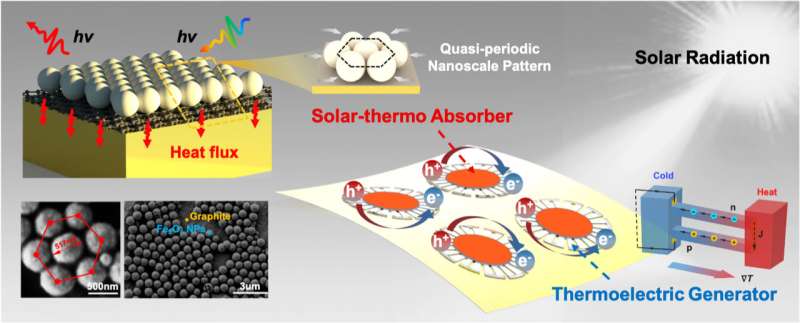This article has been reviewed according to Science X's editorial process and policies. Editors have highlighted the following attributes while ensuring the content's credibility:
fact-checked
trusted source
proofread
Nanoparticles self-assemble to harvest solar energy

Solar-thermal technology is a promising, environmentally friendly energy harvesting method with a potential role to play in solving the fossil fuel energy crisis.
The technology transforms sunlight into thermal energy, but it's challenging to suppress energy dissipation while maintaining high absorption. Existing solar energy harvesters that rely on micro- or nanoengineering don't have sufficient scalability and flexibility, and will require a novel strategy for high-performance solar light capture while simultaneously simplifying fabrication and reducing costs.
In the article "Scalable selective absorber with quasi-periodic nanostructure for low-grade solar energy harvesting," published in APL Photonics, researchers from Harbin University, Zhejiang University, Changchun Institute of Optics, and the National University of Singapore designed a solar harvester with enhanced energy conversion capabilities.
The device employs a quasiperiodic nanoscale pattern—meaning most of it is an alternating and consistent pattern, while the remaining portion contains random defects (unlike a nanofabricated structure) that do not affect its performance. In fact, loosening the strict requirements on the periodicity of the structure significantly increases the device's scalability.
The fabrication process makes use of self-assembling nanoparticles, which form an organized material structure based on their interactions with nearby particles without any external instructions.
Thermal energy harvested by the device can be transformed to electricity using thermoelectric materials.
"Solar energy is transferred as an electromagnetic wave within a broad frequency range," said author Ying Li of Zhejiang University. "A good solar-thermal harvester should be able to absorb the wave and get hot, thereby converting solar energy into thermal energy. The process requires a high absorbance (100% is perfect), and a solar harvester should also suppress its thermal radiation to preserve the thermal energy, which requires a low thermal emissivity (zero means no radiation)."
To achieve these goals, a harvester is usually a system with a periodic nanophotonic structure. But the flexibility and scalability of these modules can be limited due to the rigidity of the pattern and high fabrication costs.
"Unlike previous strategies, our quasiperiodic nanophotonic structure is self-assembled by iron oxide (Fe3O4) nanoparticles, rather than cumbersome and costly nanofabrication," said Li.
Their quasiperiodic nanophotonic structure achieves high absorbance (greater than 94%), suppressed thermal emissivity (less than 0.2), and under natural solar illumination, the absorber features a fast and significant temperature rise (greater than 80 degrees Celsius).
Based on the absorber, the team built a flexible planar solar thermoelectric harvester, which reached a significant sustaining voltage of over 20 millivolts per square centimeter. They expect it to power 20 light-emitting diodes per square meter of solar irradiation. This strategy can serve low-power density applications for more flexible and scalable engineering of solar energy harvesting.
"We hope our quasiperiodic nanophotonic structure will inspire other work," said Li. "This highly versatile structure and our fundamental research can be used to explore the upper limit of solar energy harvesting, such as flexible scalable solar thermoelectric generators, which can serve as an assistant solar harvesting component to increase the total efficiency of photovoltaic architectures."
More information: Scalable selective absorber with quasi-periodic nanostructure for low-grade solar energy harvesting, APL Photonics (2023). DOI: 10.1063/5.0135193
Provided by American Institute of Physics




















